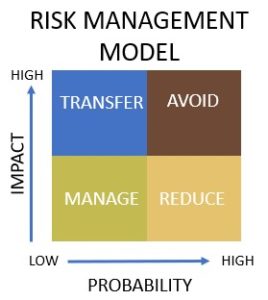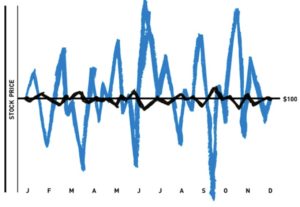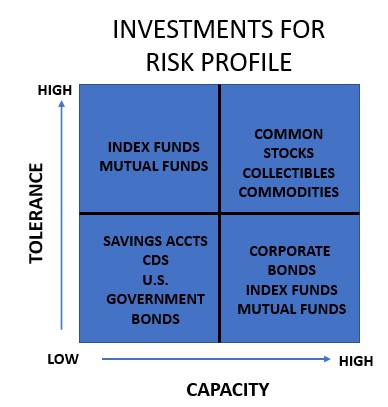Table of Contents
“Yes,” when compared to other investment choices.
An index fund is a fund with a stock portfolio designed to match or track a financial market index such as the Standard & Poor’s 500 Index, Dow Jones Industrial Average (DJIA), or the Nasdaq Composite. They provide investors a broad exposure in multiple companies, low operating expenses, and long-term returns.
Stock market professionals and investment professors from Warren Buffett to Paul Samuelson recommend index fund investing for the average person who lacks the skill, time, or interest to identify, analyze, and track individual companies’ securities. Investors have taken their advice. In 2019, the amount of assets in U.S. ETFs and index funds ($4,271 trillion) surpassed the value of actively managed mutual funds ($4.246 trillion).
Understanding Uncertainty
Safety is an emotional reaction that varies according to (1) the likelihood that a bad event will happen – what some people call “odds” or probability –and (2) the impact of the event on our life. For example, the probability of being bitten by a mosquito in a hot, humid rain forest is close to 100%, but its most likely impact is an itchy skin for a while. Conversely, the odds of being caught in a snow avalanche in a popular ski resort are low, but, if you are, death or injury is almost inevitable. There are various methods to handle risks, as reviewed in Figure 1.


Investment Risks
All investments have varying degrees of risk. Risk and reward are typically positively related. All things being equal, in a perfect world, the greater the risk, the greater the return. Logic proves this positive relationship: Given a choice between two investments with equal rewards, an average person always chooses the one with the least risk. In other words, why take a chance unless you expect to make a greater return than an investment with no risk. Recognized risks affecting investments include:
Concentration
The wisdom of not putting all of one’s eggs in a single basket has been repeated for generations. A person who spreads their eggs among several baskets reduces the impact of a single dropped basket. The same logic applies to investments. Concentrating your investment in a single asset can be devastating if the asset loses value. Spreading your investments among different assets lessens the financial impact of the price movements of a single stock. Diversification transfers the risk of a single holding to multiple holdings, spreading the risk. A portfolio of securities held in an index fund has less chance of loss than owning a single stock.

Volatility
. The change in value for an asset above and below a median price is volatility. For example, an asset with an average price of $100 that experienced a price variation of $5 up or down (the black line in Figure 2) would be considered less volatile than a $100 asset that varied $50 up and down in the same period (the blue line in Figure 1). Volatility is usually expressed in percentages. High volatility means that the price can vary significantly within a short time up or down. Volatility can be managed by using a series of buys and sells during a period to capture an average price (dollar-cost averaging)

Liquidity
A common concern of investors is whether they can sell an asset and get some, all, or extra money back. An investor in expensive art cannot usually sell a painting quickly without accepting a deep discount in market price. The ease of buying and selling is a function of the number of buyers and sellers in a market and their enthusiasm for a particular asset; the larger the group of participants, the greater the likelihood of an easy sale without suffering a decline in the asset’s value. By law, index funds are required to maintain an adequate amount of cash (around 8%) to handle sales (“withdrawals” in fund terminology), making index funds among the most liquid investments available.
Know Your Risk Profile
Each person has a unique tolerance of risk that should be considered before making any investment. For example, some people are comfortable flying a private airplane, riding a motorcycle, or hunting snakes. Others avoid these activities at all costs. Our ability to cope with risk depends on our (1) capacity to absorb a loss or setback without affecting one’s lifestyle, physical health, or mental stability and (2) tolerance (willing to accept unknowns). While each person is responsible for managing the risks in their lives, certain investments seem to be more appropriate than others for different risk profiles.

Final Thoughts
For decades, professional investment managers and individuals tried to consistently out-perform the general stock market returns as measured by broad indexes without success. Index funds, first offered by John “Jack” Bogle of Vanguard, allowed investors to replicate the returns of an – a classic case of “If you can’t beat ‘em, join ‘em.”
Index funds are intended for long term investments, to provide retirement, a child’s education, a new house. As measured by the S&P 500, the stock market can vary significantly from month to month, quarter to quarter, one year to the next. A study by Fisher Investments found that 87.5% of investors who held the equivalent of S&P 500 for a year was profitable almost 75% of the time since 1928. About 90% of those who maintained their investment for six years, 94% of those with ten-year holding periods, and all (100%) who owned the investment 20 years were profitable.

